
顧客にとっての現実を知るとはどういうことか?
前回の記事では、価値創造プロセスの一つ目となる「戦略ストーリーの直感」について、事例を用いながら具体的にお話ししました。今回は、価値創造プロセスの二つ目となる「エスノグラフィー」についてお話しします。
価値創造プロセスの全体像はこちらとなります。

固有名詞のN=1の顧客にとっての現実を感じきる
②エスノグラフィー:
直感した戦略ストーリーに対する現実を、直接経験として捉える
エスノグラフィーとは、もともと文化人類学や社会学において使用されるフィールドワークの調査手法のことです。 自分とは違った文化圏の人々の文化やコミュニティを、アンケートなどを使った数字(定量的なデータ)ではなく、観察やインタビューといった質的なデータを用いて理解するための方法論を指します。これは、戦略ストーリーにおける価値創造でも非常に有効です。
通常の市場調査では、一定のN数を集め、特定の基準でセグメンテーションして分析することが多いと思います。ですが、セグメント化されたデータ(例えば、40代女性・既婚)は、分類・分析はできても、行動の背景にある感情をリアルに感じとるには不向きです。
もちろん、場面によっては定量調査も非常に有効です。ですが、価値創造の初期段階においては、N=1の顧客の経験をまるで自分のことのようにリアルに感じ切る必要があります。そこから事業の機会や顧客の課題を発想していくことで、手触り感のある事業アイデアが育っていきます。
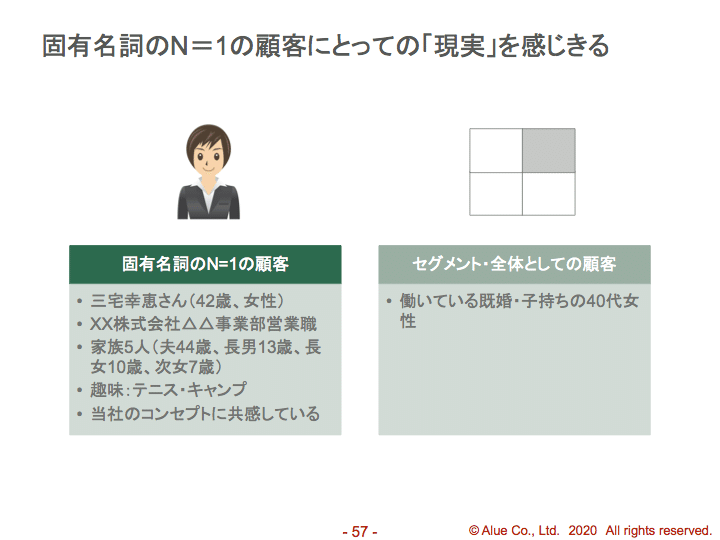
「知る」のではなく、「体感」する
ここで大切なことは、誰かが調べた内容というような2次情報によって顧客にとっての現実を「知る」のではなく、直接的な経験という1次情報として顧客にとっての現実を「体感」することです。
顧客となるN=1のAさんがいたとき、そのAさんの困りごとについてのストーリーを、全体を俯瞰する視点だけではなく、Aさん自身の視界で感じる必要があります。映画のメタファーを用いれば、全体を俯瞰する映画監督の視点だけではなく、俳優の視点で感じるということです。顧客のAさんに憑依して、Aさんがもっている困りごとについて、あたかも自分の困りごとのように感じ取るというイメージです。

Aさんがもっている困りごとを感じ取る時に、安易に判断しない姿勢も大切です。人は、これまでの経験や知識をもとに、新しい物事を判断します。このような判断が一概にいけないという話ではありませんが、新しいことを創造しようとするときには、既存の経験や知識をもとに安易に判断してしまうことは、創造のタネを見過ごしてしまうことにつながります。
ものの見方が大切
突然ですが、、、みなさんに質問です。
質問A:「これ(下の写真にあるもの)は何でしょう?」
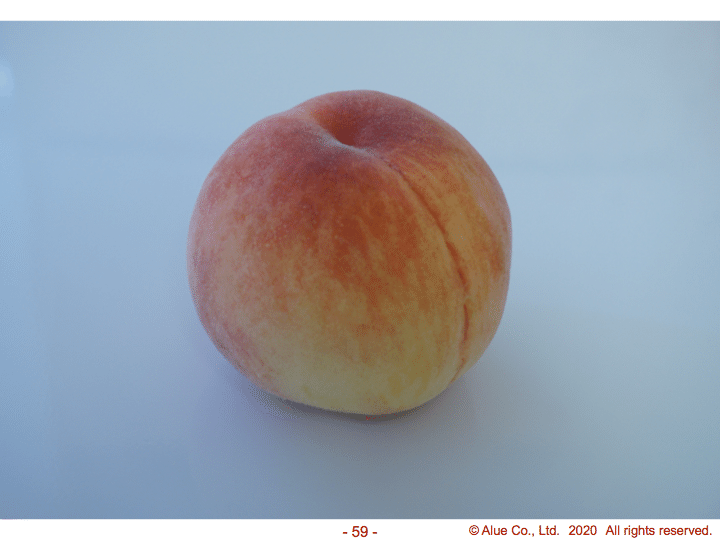
そうですね。「桃」ですね。
質問B:「それでは、これ(下の写真にあるもの)は何でしょう?」

これも「桃」ですね。。。
では、次の質問です。
質問C:「この2つは同じですか?」
はい、よく見ると、桃は桃でも、違う桃ですね。
ここでポイントとなる問いかけをしますね。
質問Aや質問Bのときにこの写真をみたときの桃の見方と、質問Cのときの桃の見方は同じでしたか?
おそらく違ったのではないでしょうか。質問Aや質問Bのときは、パッと見た瞬間に「桃だな」と思われたのではないでしょうか。質問Cのときは、「桃は桃でも、どんな特徴があるのだろうか?」という見方をされたのではないでしょうか。
この見方の違いが重要です。質問Aや質問Bのときの見方は、ものをみたときに、既存の知識や経験によってラベリングすることによって、既存の枠組みの中に整理するという見方です。質問Cのときの見方は、ものをみたときに、その特徴を捉えようとする見方です。

エスノグラフィーにおいては、「桃」とラベリングする見方(質問Aや質問Bのときの見方)ではなく、「桃は桃でも、どんな桃?」という見方(質問Cのときの見方)を大切にします。さらには、「桃」というラベリングさえもせずに、「(純粋に)これはなんだろう?」という見方ができるとベストです。子供が、新しいものを見たり、新しい経験をしたりしたときの見方・感じ方ですね。
自分の困りごとや身近な大切な人の困りごとに注目する
では、どのようにすれば、固有名詞のN=1の顧客の困りごとを感じとることができるのでしょうか?
すでに顧客がいる場合であっても、改めて顧客の困りごとを聞くというのは簡単なことではありません。ましてや、まだ顧客がいないという場合はどうすればいいのでしょうか?
そのようなときは、自分の困りごとや、身近な大切な人の困りごとに寄り添うということを私は実践しています。

具体的な事例を交えてご説明します。最初の事例は、自分の困り事をもとに着想した事例です。
当社の創業当初の主な商品は、100本ノックという「習うよりも慣れろ」をコンセプトとした実践型の教育プログラムであることは以前の記事でもご紹介しました。100本ノックを構想しているときに、エスノグラフィーとして立ち返ったのは自分たちの体験からくる自分たちの困りごとでした。
小中高校、そして大学で教わったことは、とても有意義なことが多いと感じていますが、その教育スタイルは多くの場合、先生が話している内容を多くの生徒が聞くという一方向型でインプット中心のものでした。
一方で、コンサルティング会社において様々なことを学んだプロセスは、研修プログラムという形ではありませんでしたが、自分のアウトプットに対して何度もフィードバックを受けることによって学んでいくという双方向型でアウトプット中心のものでした。
どちらもメリット・デメリットがある話ですから、0-100の話ではありませんが、少なくとも一方向型でインプット中心の教育スタイルが、「当たり前」のものとして無批判に採用されている当時の社会人教育には疑問が湧きました。それでは「頭では理解できても、仕事で使えるようにはならない」という感覚が、それまでの受けてきた経験からありありと感じられていたのです。
これは、自社の顧客に対してインタビューをするというアプローチではありませんが、自分自身が顧客(この場合は生徒)としての困りごとを感じてきたことに注目するアプローチと捉えることができます。

別の事例として、当社は最近、中堅中小企業向け事業の展開を構想していますが、そのエスノグラフィーの実践事例をお話しします。
中堅中小企業は大企業同様に社員育成ニーズはあるものの、企業あたりの取引金額は大企業よりは低く、いいサービスを提供したとしても、育成施策が一巡してしまい、新たな対象者がいなくなればリピートオーダーをいただくことができないという特徴があります。
これまでは、対面型の社員育成サービスを前提としていたために、このような課題にぶつかってしまい、大企業のみをターゲットとしていたのですが、etudesというeラーニングのプラットフォーム(LMS=Learning Management System)を事業譲受したことによって、その道が開かれることになりました。対面型の育成サービスが提供できなくても、eラーニングあるいはLMSでのサービス提供を継続的にできるようになったからです。
事業の構想をしている時期に、地元の少年野球チームで一緒にコーチをしているTさんから「社内の人材育成を強化したいと思っているのですが、御社の営業担当の方をご紹介していただけますか?」というご相談を頂きました。Tさんの会社は、社員数が数百人であり、当社の定義としては中堅中小企業にあたります。
このときに、営業担当をご紹介して、「商談」として進めることもできたのですが、せっかくTさんからお声がけしてもらったので、直接お役に立ちたいという気持ちがあったことと、中堅中小企業のお客様としてのエスノグラフィーをさせていただく機会として、通常とは異なるアプローチを取りました。
それは、「お困りごとを聞かせて頂き、どのような解決の方向性があるかを一緒に対話するセッション」を1回2時間で、3〜4回実施させていただくという内容です。
このような内容をTさんに提案したときに、Tさんはとても驚いていました。「営業の方をご紹介いただけるだけでも有難いのに、社長自らたくさんの時間をとっていただくのは気が引けます」というようなコメントを頂きました。
このようなプロセスを踏ませていただくことが、Tさんの会社にとっても有意義な解決策が見いだせるプロセスになるだけではなく、当社の事業構想にとっても有難いことであることをお伝えした所、快諾いただき、「対話セッション」を複数回実施することになりました。こちらからお願いしていることなので、当然のことながら無償で実施させていただきました。
また、ほぼ同時期に、中学高校時代に塾が一緒だったKさんから連絡があり、「社内の人材育成を強化していきたいと考えている」ということを聞かせていただきました。Kさんにも、「悩みを聞かせていただき、解決策を一緒に考えるセッション」を複数回実施すること、また、そのような提案の背景を当社の事情も含めてお話ししたところ、快諾頂きました。
そのようなセッションを通じて、人や組織関する課題としてどのようなことがあり、それらの課題がどのように影響を会社全体やビジネスにもたらしているのかといったことや、解決策を実施するときに、どのような制約条件を踏まえなければいけないのか、誰を巻き込んで合意形成する必要があるのか、など、さまざまなことを感じ取ることができました。

その中には、Tさんの会社、Kさんの会社それぞれ特有の話も当然ながらありますが、多くの中堅中小企業にも共通するような課題も含まれていました。そして、その内容は、中堅中小企業向けの事業構想に大いに役立つものでした。
このようなTさんやKさんとのやりとりは、身近な人の困りごとをなるべく直接的に感じ取らせていただく機会をもつアプローチと言えるでしょう。
今回の記事では、価値創造プロセスの二つ目となる「エスノグラフィー」についてお話ししました。次回の記事では、三つ目のプロセスとなる「戦略ストーリーの導出」についてお話しします。
本日の問いとなります。(よろしければ、コメントにご意見ください)
・あなたの普段の生活の中で、記事中にあった3つのものの見方(以下の3つの見方を参照)を意識的に使い分けることができたとすると、どんないいことがありそうでしょうか?
「桃」を見るときの3つの見方
▼「桃とラベリングしてみる」見方
▼「桃は桃でも、どんな桃か?」という見方
▼「(純粋に)これはなんだろう?」という見方
・あなたが携わる事業において、エスノグラフィーを実践するとしたら、どんな自分の困りごとや、身近な人の困りごとに注目すると良さそうでしょうか?
What does it mean to know the reality for customers?
In my previous article, I discussed the first process of value creation, " Intuition of a Strategy Story," in detail, using examples. In this article, I would like to talk about the second process of value creation, "ethnography."
The entire value creation process can be seen here.
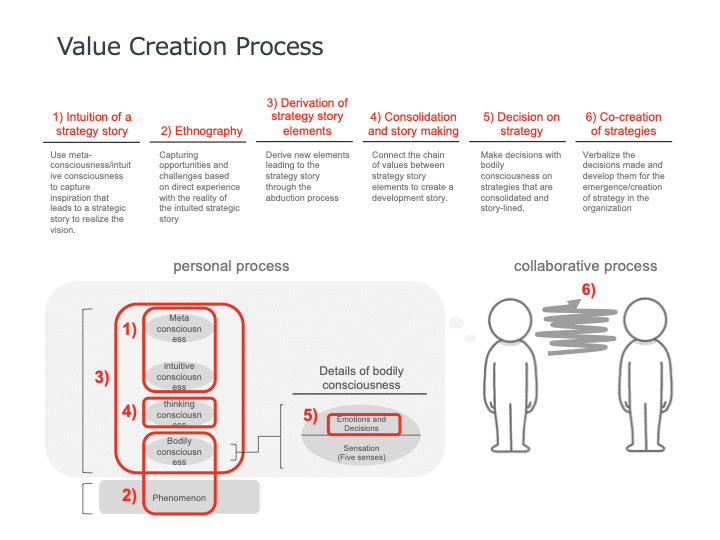
Perceive the reality for N=1 specific customer
2) Ethnography:
Perceive the reality to the intuited strategy story as a direct experience.
Ethnography is a fieldwork research methodology originally used in cultural anthropology and sociology. It refers to a methodology for understanding the culture and community of people from cultures different from one's own, using qualitative data such as observations and interviews, rather than numbers (quantitative data) using questionnaires. This is also very effective in value creation in strategy stories.
In normal market research, a certain number of N is collected and segmented based on specific characteristics for analysis. However, although segmented data (e.g., women in their 40s, married) can be categorized and analyzed, it is not suitable for getting a real sense of the emotions behind the behavior.
Of course, quantitative research is very effective in some situations. However, in the initial stage of value creation, it is necessary to fully feel the experience of the N=1 customer as if it were our own. From this, we can develop business opportunities and customer issues, which will help us to develop business ideas with a realistic feeling.
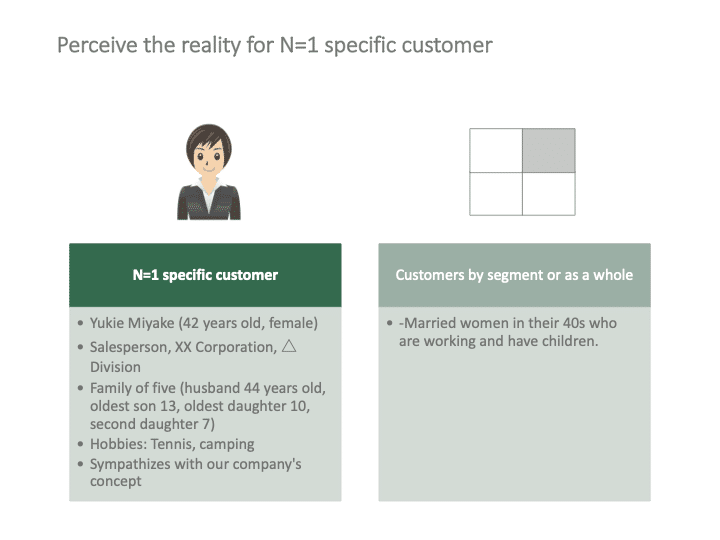
Feel it, rather than know it
The important thing here is not to "know" the reality for the customer through secondary information such as what someone has researched, but to "feel" the reality for the customer through primary information such as direct experience.
When there is a customer, Ms. A (N=1), it is necessary to feel the story of her problem not only from a bird's eye view, but also from her own perspective. Using a movie metaphor, this means that we need to feel the story from the point of view of the actor, not just from the point of view of the movie director, who has a bird's eye view of the whole story. It is like being in Ms. A's shoes and perceiving her problems as if her problems were our own.

It is also important not to make snap judgments when sensing the problems that Ms. A has. People often judge new things based on their past experiences and knowledge. This is not to say that such judgments are generally wrong, but when trying to create something new, making easy judgments based on existing experience and knowledge can lead to overlooking the seeds of creation.
The way we look at things is important
Here's a question for you....
Question A: "What is this (what you see in the picture below)?"

That's right. It's a peach.
Question B: "Then what is this (the one in the picture below)?"

It's also "peach".
Now, the next question.
Question C: "Are these two the same?"
Yes, if you look closely, both of these are peaches, but they are different peaches.
Let me ask you a key question here.
Did you see the peaches the same way when you looked at these pictures in question A or B, compared to when you looked at them in question C?
Perhaps it was different. When it came to questions A and B, you probably thought, "That's a peach," as soon as you saw it. For question C, you may have thought, "These are peaches, but what characteristics do they have?"
This difference in perspective is important. The way of looking at things in questions A and B is to organize them within an existing framework by labeling them with existing knowledge and experience. Question C is the way of looking at something and trying to capture its characteristics.
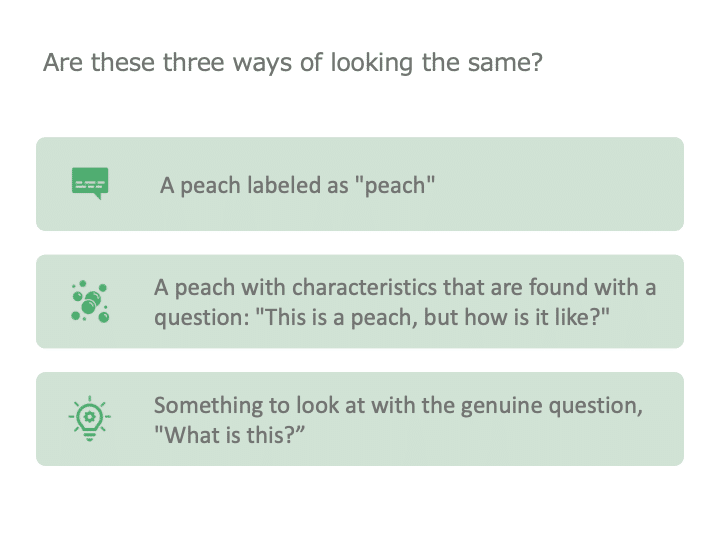
In ethnography, it is important to look at "this is a peach, but how is it like ?" (the way we look at it in question C), rather than looking at labeling it as a "peach" (the way we look at it in questions A and B). It is also best if we can purely see it as, "What is this?" without even labeling it as a peach. This is the way children see and feel when they see something new or have a new experience.
Focus on your own problems and those of your neighbors
So how can we sense the problems of N=1 specific customer?
Even if we already have customers, it is not easy to ask them again about their problems. What should you do if there are no customers yet?
At such times, my practice is to stay close to my own problems and the problems of my near and dear ones.
I will explain with specific examples. The first example is an inspired case based on my own problems.
As I mentioned in a previous article, our main product at the beginning of the company was 100 Fungos, a hands-on educational program based on the concept of "get used to it before learning it." When we were conceiving 100 Fungos, we came back to our own problems from our own experiences.
I feel that many of the things I was taught in elementary, middle and high school, as well as in university, were very meaningful, but the style of education was often one-way and input-oriented, with many students listening to what the teacher was saying.
On the other hand, the process of learning various things at the consulting company was not in the form of a training program, but it was interactive and output-oriented, where I learned by receiving feedback on my output repeatedly.
Both of them have their own merits and demerits, so it's not a 0-100 story, but at the very least, I began to have doubts about the education for working adults at the time, which was uncritically adopting a one-way, input-oriented style of education as the standard. The experience I'd had up to that time had given me the feeling that even if I understood something in my head, I wouldn't be able to use it at work.
This is not an approach to interviewing our own customers, but it can be seen as an approach to focus on what we ourselves have found troubling as customers (in this case, students).
As another case study, I would like to share an example of ethnography in action, as we have recently envisioned developing a business for small and medium-sized companies.
Although small and midsize companies have the same needs for employee training as large companies, the transaction amount per company is lower than that of large companies, and even if we provide a good service, we will not be able to receive repeat orders once the training measures have run their course and there are no new targets.
Up until now, we had been targeting only large corporations because we had run into these issues with our face-to-face employee training services, but the acquisition of etudes, an e-learning platform (LMS=Learning Management System), has opened the door for us. That's because even if we could not provide face-to-face training services, we could continue to provide services through e-learning or LMS.
During the time when we were planning our business, Mr. T, who is coaching a local youth baseball team with me, asked me, "I would like to strengthen our internal human resource development." Mr. T's company has a few hundred employees, and our company defines it as a small to medium-sized company.
At that time, I could have introduced the sales representative and proceeded with the "business opportunity," but since Mr. T had approached me, I took a different approach because I wanted to help him directly and because it was an opportunity for me to do an ethnography as a customer of a small to medium-sized company.
It consists of three to four sessions of two hours each, where we listen to their problems and discuss with them what direction they should take to solve them.
When I proposed this to Mr. T, he was very surprised. He commented, "I would appreciate it if you could introduce me to a sales person, but I don't feel comfortable asking the president to spend a lot of time with me."
When I mentioned that this process would not only help Mr. T's company to find a meaningful solution, but would also be beneficial to our company's business concept, he readily agreed to let us hold several "dialogue sessions". Since it was our request, we of course conducted the sessions free of charge.
At about the same time, Mr. K, who had attended a cram school with me when we were in junior high and high school, contacted me and told me that he wanted to strengthen human resource development in his company.
When we told Mr. K that we would hold several "sessions where we would listen to his concerns and think about solutions together" and the background of such a proposal, including our own circumstances, he readily agreed.
Through these sessions, I was able to get a sense of what issues are related to people and organizations, how these issues affect the company as a whole and the business, what constraints need to be taken into account when implementing solutions, who needs to be involved in building consensus, and many other things.
While some of the stories were specific to Mr. T's company and Mr. K's company, they also included issues that are common to many small and medium-sized companies. The content was very useful for our business concept for small and medium-sized companies.
This kind of interaction with Mr. T and Ms. K can be described as an approach that gives us the opportunity to directly feel the problems of the people around us.
In this article, I talked about the second process of value creation, "ethnography." In the next article, I will discuss the third process, "deriving a strategy story."
Here are the quests of the day. (If you'd like, please share your thoughts in the comments.)
・If you were able to consciously use the three ways of looking at things mentioned in the article (see the three ways below) in your everyday life, what good would come to you?•
Three ways to look at "a peach"
・A peach labeled as "peach"
・A peach with characteristics that are found with a question: "This is a peach, but how is it like?"
・Something to look at with the genuine question, "What is this?”
・If you were to practice ethnography in the business you are involved in, what kinds of problems of yours or those of people close to you would be good to focus on?
Bunshiro Ochiai
この記事が気に入ったらサポートをしてみませんか?
